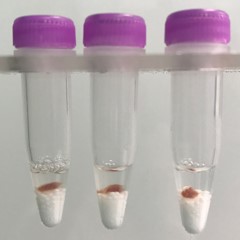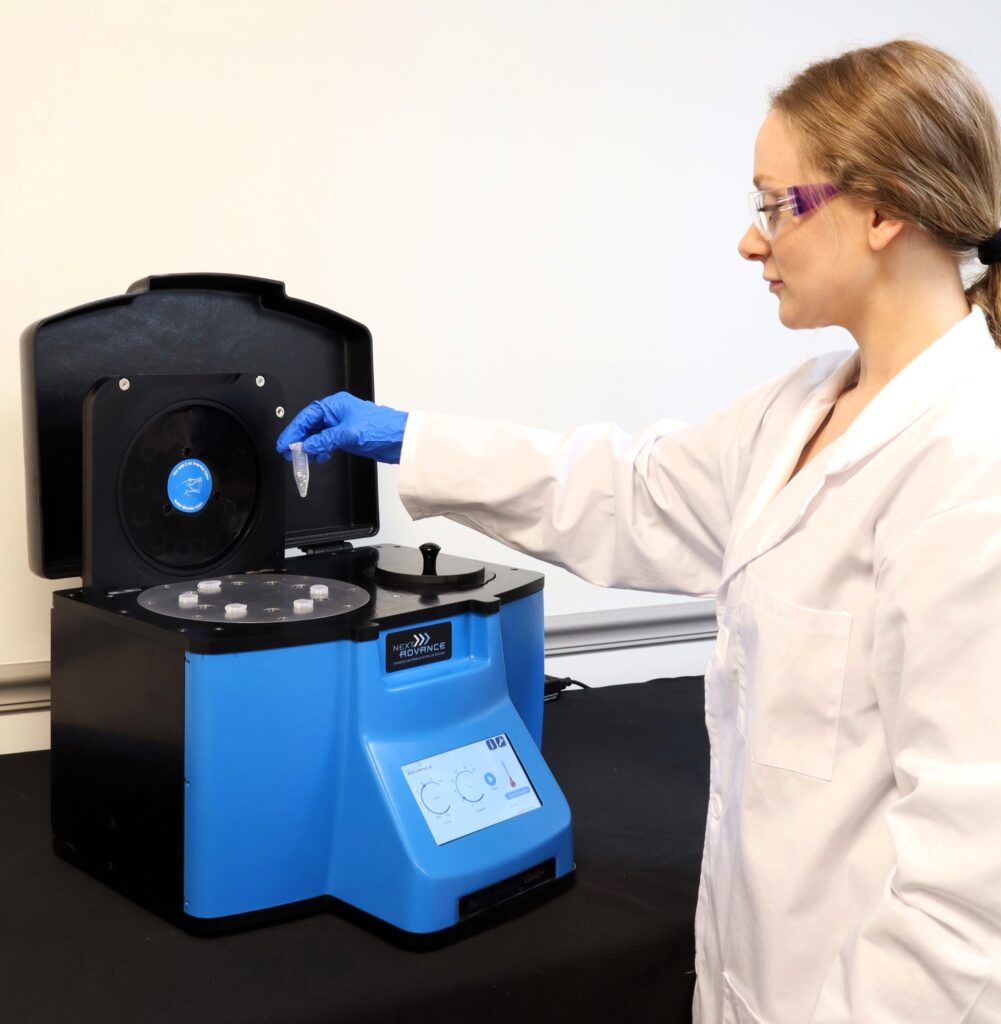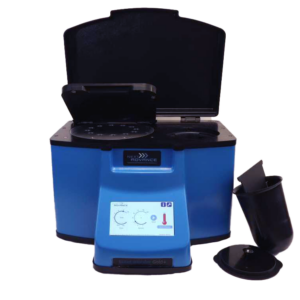Ideal for Pancreas Tissue Homogenization
Do you spend lots of time and effort homogenizing pancreas tissue samples? The Bullet Blender® tissue homogenizer delivers high quality and superior yields. No other homogenizer comes close to delivering the Bullet Blender’s winning combination of top-quality performance and budget-friendly affordability. See below for a pancreas tissue homogenization protocol.
Save Time, Effort and Get Superior Results with
The Bullet Blender Homogenizer
Consistent and High Yield Results
Run up to 24 samples at the same time under microprocessor-controlled conditions, ensuring experimental reproducibility and high yield. Process samples from 10mg or less up to 3.5g.No Cross Contamination
No part of the Bullet Blender ever touches the tissue – the sample tubes are kept closed during homogenization. There are no probes to clean between samples.Samples Stay Cool
The Bullet Blenders’ innovative and elegant design provides convective cooling of the samples, so they do not heat up more than several degrees. In fact, our Gold+ models hold the sample temperature to about 4ºC.Easy and Convenient to Use
Just place beads and buffer along with your tissue sample in standard tubes, load tubes directly in the Bullet Blender, select time and speed, and press start.Risk Free Purchase
Thousands of peer-reviewed journal articles attest to the consistency and quality of the Bullet Blender homogenizer. We offer a 2 year warranty, extendable to 4 years, because our Bullet Blenders are reliable and last for many years.Pancreas Tissue Homogenization Protocol
Sample size |
See the Protocol |
| microcentrifuge tube model (up to 300 mg) | Small pancreas samples |
| 5mL tube model (100mg - 1g) | Medium pancreas samples |
| 50mL tube model (100mg - 3.5g) | Large pancreas samples |
What Else Can You Homogenize? Tough or Soft, No Problem!
The Bullet Blender can process a wide range of samples including organ tissue, cell culture, plant tissue, and small organisms. You can homogenize samples as tough as mouse femur or for gentle applications such as tissue dissociation or organelle isolation.



Pancreas tissue pieces (on beads in upper photo) are completely homogenized into the buffer (slightly darker in lower photo).
Want more guidance? Need a quote? Contact us:

Bullet Blender Models
Select Publications using the Bullet Blender to Homogenize Pancreas Tissue
2474232
pancreas
1
apa
50
date
desc
3213
https://www.nextadvance.com/wp-content/plugins/zotpress/
%7B%22status%22%3A%22success%22%2C%22updateneeded%22%3Afalse%2C%22instance%22%3Afalse%2C%22meta%22%3A%7B%22request_last%22%3A0%2C%22request_next%22%3A0%2C%22used_cache%22%3Atrue%7D%2C%22data%22%3A%5B%7B%22key%22%3A%22Q95J3I6K%22%2C%22library%22%3A%7B%22id%22%3A2474232%7D%2C%22meta%22%3A%7B%22creatorSummary%22%3A%22Johns%20et%20al.%22%2C%22parsedDate%22%3A%222016-04-15%22%2C%22numChildren%22%3A2%7D%2C%22bib%22%3A%22%3Cdiv%20class%3D%5C%22csl-bib-body%5C%22%20style%3D%5C%22line-height%3A%202%3B%20padding-left%3A%201em%3B%20text-indent%3A-1em%3B%5C%22%3E%5Cn%20%20%3Cdiv%20class%3D%5C%22csl-entry%5C%22%3EJohns%2C%20M.%2C%20Esmaeili%20Mohsen%20Abadi%2C%20S.%2C%20Malik%2C%20N.%2C%20Lee%2C%20J.%2C%20Neumann%2C%20W.%20L.%2C%20Rausaria%2C%20S.%2C%20Imani-Nejad%2C%20M.%2C%20McPherson%2C%20T.%2C%20Schober%2C%20J.%2C%20%26amp%3B%20Kwon%2C%20G.%20%282016%29.%20Oral%20administration%20of%20SR-110%2C%20a%20peroxynitrite%20decomposing%20catalyst%2C%20enhances%20glucose%20homeostasis%2C%20insulin%20signaling%2C%20and%20islet%20architecture%20in%20B6D2F1%20mice%20fed%20a%20high%20fat%20diet.%20%3Ci%3EArchives%20of%20Biochemistry%20and%20Biophysics%3C%5C%2Fi%3E%2C%20%3Ci%3E596%3C%5C%2Fi%3E%2C%20126%26%23x2013%3B137.%20%3Ca%20class%3D%27zp-DOIURL%27%20href%3D%27https%3A%5C%2F%5C%2Fdoi.org%5C%2F10.1016%5C%2Fj.abb.2016.03.002%27%3Ehttps%3A%5C%2F%5C%2Fdoi.org%5C%2F10.1016%5C%2Fj.abb.2016.03.002%3C%5C%2Fa%3E%3C%5C%2Fdiv%3E%5Cn%3C%5C%2Fdiv%3E%22%2C%22data%22%3A%7B%22itemType%22%3A%22journalArticle%22%2C%22title%22%3A%22Oral%20administration%20of%20SR-110%2C%20a%20peroxynitrite%20decomposing%20catalyst%2C%20enhances%20glucose%20homeostasis%2C%20insulin%20signaling%2C%20and%20islet%20architecture%20in%20B6D2F1%20mice%20fed%20a%20high%20fat%20diet%22%2C%22creators%22%3A%5B%7B%22creatorType%22%3A%22author%22%2C%22firstName%22%3A%22Michael%22%2C%22lastName%22%3A%22Johns%22%7D%2C%7B%22creatorType%22%3A%22author%22%2C%22firstName%22%3A%22Sakineh%22%2C%22lastName%22%3A%22Esmaeili%20Mohsen%20Abadi%22%7D%2C%7B%22creatorType%22%3A%22author%22%2C%22firstName%22%3A%22Nehal%22%2C%22lastName%22%3A%22Malik%22%7D%2C%7B%22creatorType%22%3A%22author%22%2C%22firstName%22%3A%22Joshua%22%2C%22lastName%22%3A%22Lee%22%7D%2C%7B%22creatorType%22%3A%22author%22%2C%22firstName%22%3A%22William%20L.%22%2C%22lastName%22%3A%22Neumann%22%7D%2C%7B%22creatorType%22%3A%22author%22%2C%22firstName%22%3A%22Smita%22%2C%22lastName%22%3A%22Rausaria%22%7D%2C%7B%22creatorType%22%3A%22author%22%2C%22firstName%22%3A%22Maryam%22%2C%22lastName%22%3A%22Imani-Nejad%22%7D%2C%7B%22creatorType%22%3A%22author%22%2C%22firstName%22%3A%22Timothy%22%2C%22lastName%22%3A%22McPherson%22%7D%2C%7B%22creatorType%22%3A%22author%22%2C%22firstName%22%3A%22Joseph%22%2C%22lastName%22%3A%22Schober%22%7D%2C%7B%22creatorType%22%3A%22author%22%2C%22firstName%22%3A%22Guim%22%2C%22lastName%22%3A%22Kwon%22%7D%5D%2C%22abstractNote%22%3A%22Peroxynitrite%20has%20been%20implicated%20in%20type%202%20diabetes%20and%20diabetic%20complications.%20As%20a%20follow-up%20study%20to%20our%20previous%20work%20on%20SR-135%20%28Arch%20Biochem%20Biophys%20577%5Cu2013578%3A%2049%5Cu201359%2C%202015%29%2C%20we%20provide%20evidence%20that%20this%20series%20of%20compounds%20are%20effective%20when%20administered%20orally%2C%20and%20their%20mechanisms%20of%20actions%20extend%20to%20the%20peripheral%20tissues.%20A%20more%20soluble%20analogue%20of%20SR-135%2C%20SR-110%20%28from%20a%20new%20class%20of%20Mn%28III%29%20bis%28hydroxyphenyl%29-dipyrromethene%20complexes%29%20was%20orally%20administered%20for%202%20weeks%20to%20B6D2F1%20mice%20fed%20a%20high%20fat-diet%20%28HFD%29.%20Mice%20fed%20a%20HFD%20for%204%20months%20gained%20significantly%20higher%20body%20weights%20compared%20to%20lean%20diet-fed%20mice%20%2852%5Cu00a0%5Cu00b1%5Cu00a01.5%5Cu00a0g%20vs%2034%5Cu00a0%5Cu00b1%5Cu00a01.3%5Cu00a0g%29.%20SR-110%20%2810%5Cu00a0mg%5C%2Fkg%20daily%29%20treatment%20significantly%20reduced%20fasting%20blood%20glucose%20and%20insulin%20levels%2C%20and%20enhanced%20glucose%20tolerance%20as%20compared%20to%20HFD%20control%20or%20vehicle%20%28peanut%20butter%29%20group.%20SR-110%20treatment%20enhanced%20insulin%20signaling%20in%20the%20peripheral%20organs%2C%20liver%2C%20heart%2C%20and%20skeletal%20muscle%2C%20and%20reduced%20lipid%20accumulation%20in%20the%20liver.%20Furthermore%2C%20SR-110%20increased%20insulin%20content%2C%20restored%20islet%20architecture%2C%20decreased%20islet%20size%2C%20and%20reduced%20tyrosine%20nitration.%20These%20results%20suggest%20that%20a%20peroxynitrite%20decomposing%20catalyst%20is%20effective%20in%20improving%20glucose%20homeostasis%20and%20restoring%20islet%20morphology%20and%20%5Cu03b2-cell%20insulin%20content%20under%20nutrient%20overload.%22%2C%22date%22%3A%22April%2015%2C%202016%22%2C%22language%22%3A%22%22%2C%22DOI%22%3A%2210.1016%5C%2Fj.abb.2016.03.002%22%2C%22ISSN%22%3A%220003-9861%22%2C%22url%22%3A%22http%3A%5C%2F%5C%2Fwww.sciencedirect.com%5C%2Fscience%5C%2Farticle%5C%2Fpii%5C%2FS0003986116300546%22%2C%22collections%22%3A%5B%22M2MNG549%22%5D%2C%22dateModified%22%3A%222016-06-24T16%3A14%3A56Z%22%7D%7D%2C%7B%22key%22%3A%22QQUGU3XB%22%2C%22library%22%3A%7B%22id%22%3A2474232%7D%2C%22meta%22%3A%7B%22creatorSummary%22%3A%22Albury-Warren%20et%20al.%22%2C%22parsedDate%22%3A%222015-10-20%22%2C%22numChildren%22%3A0%7D%2C%22bib%22%3A%22%3Cdiv%20class%3D%5C%22csl-bib-body%5C%22%20style%3D%5C%22line-height%3A%202%3B%20padding-left%3A%201em%3B%20text-indent%3A-1em%3B%5C%22%3E%5Cn%20%20%3Cdiv%20class%3D%5C%22csl-entry%5C%22%3EAlbury-Warren%2C%20T.%20M.%2C%20Pandey%2C%20V.%2C%20Spinel%2C%20L.%20P.%2C%20Masternak%2C%20M.%2C%20%26amp%3B%20Altomare%2C%20D.%20A.%20%282015%29.%20Prediabetes%20linked%20to%20excess%20glucagon%20in%20transgenic%20mice%20with%20pancreatic%20active%20AKT1.%20%3Ci%3EJournal%20of%20Endocrinology%3C%5C%2Fi%3E%2C%20JOE-15-0288.%20%3Ca%20class%3D%27zp-DOIURL%27%20href%3D%27https%3A%5C%2F%5C%2Fdoi.org%5C%2F10.1530%5C%2FJOE-15-0288%27%3Ehttps%3A%5C%2F%5C%2Fdoi.org%5C%2F10.1530%5C%2FJOE-15-0288%3C%5C%2Fa%3E%3C%5C%2Fdiv%3E%5Cn%3C%5C%2Fdiv%3E%22%2C%22data%22%3A%7B%22itemType%22%3A%22journalArticle%22%2C%22title%22%3A%22Prediabetes%20linked%20to%20excess%20glucagon%20in%20transgenic%20mice%20with%20pancreatic%20active%20AKT1%22%2C%22creators%22%3A%5B%7B%22creatorType%22%3A%22author%22%2C%22firstName%22%3A%22Toya%20Marquita%22%2C%22lastName%22%3A%22Albury-Warren%22%7D%2C%7B%22creatorType%22%3A%22author%22%2C%22firstName%22%3A%22Veethika%22%2C%22lastName%22%3A%22Pandey%22%7D%2C%7B%22creatorType%22%3A%22author%22%2C%22firstName%22%3A%22Lina%20P%22%2C%22lastName%22%3A%22Spinel%22%7D%2C%7B%22creatorType%22%3A%22author%22%2C%22firstName%22%3A%22Michal%22%2C%22lastName%22%3A%22Masternak%22%7D%2C%7B%22creatorType%22%3A%22author%22%2C%22firstName%22%3A%22Deborah%20A%22%2C%22lastName%22%3A%22Altomare%22%7D%5D%2C%22abstractNote%22%3A%22%22%2C%22date%22%3A%222015-10-20%22%2C%22language%22%3A%22en%22%2C%22DOI%22%3A%2210.1530%5C%2FJOE-15-0288%22%2C%22ISSN%22%3A%220022-0795%2C%201479-6805%22%2C%22url%22%3A%22http%3A%5C%2F%5C%2Fjoe.endocrinology-journals.org%5C%2Flookup%5C%2Fdoi%5C%2F10.1530%5C%2FJOE-15-0288%22%2C%22collections%22%3A%5B%22M2MNG549%22%5D%2C%22dateModified%22%3A%222015-10-30T19%3A59%3A18Z%22%7D%7D%2C%7B%22key%22%3A%22HH4RKK8V%22%2C%22library%22%3A%7B%22id%22%3A2474232%7D%2C%22meta%22%3A%7B%22creatorSummary%22%3A%22Kwon%20et%20al.%22%2C%22parsedDate%22%3A%222015-06-22%22%2C%22numChildren%22%3A0%7D%2C%22bib%22%3A%22%3Cdiv%20class%3D%5C%22csl-bib-body%5C%22%20style%3D%5C%22line-height%3A%202%3B%20padding-left%3A%201em%3B%20text-indent%3A-1em%3B%5C%22%3E%5Cn%20%20%3Cdiv%20class%3D%5C%22csl-entry%5C%22%3EKwon%2C%20J.%20J.%2C%20Nabinger%2C%20S.%20C.%2C%20Vega%2C%20Z.%2C%20Sahu%2C%20S.%20S.%2C%20Alluri%2C%20R.%20K.%2C%20Abdul-Sater%2C%20Z.%2C%20Yu%2C%20Z.%2C%20Gore%2C%20J.%2C%20Nalepa%2C%20G.%2C%20Saxena%2C%20R.%2C%20Korc%2C%20M.%2C%20%26amp%3B%20Kota%2C%20J.%20%282015%29.%20Pathophysiological%20role%20of%20microRNA-29%20in%20pancreatic%20cancer%20stroma.%20%3Ci%3EScientific%20Reports%3C%5C%2Fi%3E%2C%20%3Ci%3E5%3C%5C%2Fi%3E%2C%2011450.%20%3Ca%20class%3D%27zp-DOIURL%27%20href%3D%27https%3A%5C%2F%5C%2Fdoi.org%5C%2F10.1038%5C%2Fsrep11450%27%3Ehttps%3A%5C%2F%5C%2Fdoi.org%5C%2F10.1038%5C%2Fsrep11450%3C%5C%2Fa%3E%3C%5C%2Fdiv%3E%5Cn%3C%5C%2Fdiv%3E%22%2C%22data%22%3A%7B%22itemType%22%3A%22journalArticle%22%2C%22title%22%3A%22Pathophysiological%20role%20of%20microRNA-29%20in%20pancreatic%20cancer%20stroma%22%2C%22creators%22%3A%5B%7B%22creatorType%22%3A%22author%22%2C%22firstName%22%3A%22Jason%20J.%22%2C%22lastName%22%3A%22Kwon%22%7D%2C%7B%22creatorType%22%3A%22author%22%2C%22firstName%22%3A%22Sarah%20C.%22%2C%22lastName%22%3A%22Nabinger%22%7D%2C%7B%22creatorType%22%3A%22author%22%2C%22firstName%22%3A%22Zachary%22%2C%22lastName%22%3A%22Vega%22%7D%2C%7B%22creatorType%22%3A%22author%22%2C%22firstName%22%3A%22Smiti%20Snigdha%22%2C%22lastName%22%3A%22Sahu%22%7D%2C%7B%22creatorType%22%3A%22author%22%2C%22firstName%22%3A%22Ravi%20K.%22%2C%22lastName%22%3A%22Alluri%22%7D%2C%7B%22creatorType%22%3A%22author%22%2C%22firstName%22%3A%22Zahi%22%2C%22lastName%22%3A%22Abdul-Sater%22%7D%2C%7B%22creatorType%22%3A%22author%22%2C%22firstName%22%3A%22Zhangsheng%22%2C%22lastName%22%3A%22Yu%22%7D%2C%7B%22creatorType%22%3A%22author%22%2C%22firstName%22%3A%22Jesse%22%2C%22lastName%22%3A%22Gore%22%7D%2C%7B%22creatorType%22%3A%22author%22%2C%22firstName%22%3A%22Grzegorz%22%2C%22lastName%22%3A%22Nalepa%22%7D%2C%7B%22creatorType%22%3A%22author%22%2C%22firstName%22%3A%22Romil%22%2C%22lastName%22%3A%22Saxena%22%7D%2C%7B%22creatorType%22%3A%22author%22%2C%22firstName%22%3A%22Murray%22%2C%22lastName%22%3A%22Korc%22%7D%2C%7B%22creatorType%22%3A%22author%22%2C%22firstName%22%3A%22Janaiah%22%2C%22lastName%22%3A%22Kota%22%7D%5D%2C%22abstractNote%22%3A%22%22%2C%22date%22%3A%222015-6-22%22%2C%22language%22%3A%22%22%2C%22DOI%22%3A%2210.1038%5C%2Fsrep11450%22%2C%22ISSN%22%3A%222045-2322%22%2C%22url%22%3A%22http%3A%5C%2F%5C%2Fwww.nature.com%5C%2Farticles%5C%2Fsrep11450%22%2C%22collections%22%3A%5B%22M2MNG549%22%5D%2C%22dateModified%22%3A%222016-01-11T20%3A24%3A02Z%22%7D%7D%2C%7B%22key%22%3A%22X9F9E8BR%22%2C%22library%22%3A%7B%22id%22%3A2474232%7D%2C%22meta%22%3A%7B%22creatorSummary%22%3A%22Borschensky%20and%20Reinacher%22%2C%22parsedDate%22%3A%222014%22%2C%22numChildren%22%3A0%7D%2C%22bib%22%3A%22%3Cdiv%20class%3D%5C%22csl-bib-body%5C%22%20style%3D%5C%22line-height%3A%202%3B%20padding-left%3A%201em%3B%20text-indent%3A-1em%3B%5C%22%3E%5Cn%20%20%3Cdiv%20class%3D%5C%22csl-entry%5C%22%3EBorschensky%2C%20C.%20M.%2C%20%26amp%3B%20Reinacher%2C%20M.%20%282014%29.%20Mutations%20in%20the%203c%20and%207b%20genes%20of%20feline%20coronavirus%20in%20spontaneously%20affected%20FIP%20cats.%20%3Ci%3EResearch%20in%20Veterinary%20Science%3C%5C%2Fi%3E%2C%20%3Ci%3E97%3C%5C%2Fi%3E%282%29%2C%20333%26%23x2013%3B340.%20%3Ca%20class%3D%27zp-DOIURL%27%20href%3D%27https%3A%5C%2F%5C%2Fdoi.org%5C%2F10.1016%5C%2Fj.rvsc.2014.07.016%27%3Ehttps%3A%5C%2F%5C%2Fdoi.org%5C%2F10.1016%5C%2Fj.rvsc.2014.07.016%3C%5C%2Fa%3E%3C%5C%2Fdiv%3E%5Cn%3C%5C%2Fdiv%3E%22%2C%22data%22%3A%7B%22itemType%22%3A%22journalArticle%22%2C%22title%22%3A%22Mutations%20in%20the%203c%20and%207b%20genes%20of%20feline%20coronavirus%20in%20spontaneously%20affected%20FIP%20cats%22%2C%22creators%22%3A%5B%7B%22creatorType%22%3A%22author%22%2C%22firstName%22%3A%22C.M.%22%2C%22lastName%22%3A%22Borschensky%22%7D%2C%7B%22creatorType%22%3A%22author%22%2C%22firstName%22%3A%22M.%22%2C%22lastName%22%3A%22Reinacher%22%7D%5D%2C%22abstractNote%22%3A%22%22%2C%22date%22%3A%2210%5C%2F2014%22%2C%22language%22%3A%22en%22%2C%22DOI%22%3A%2210.1016%5C%2Fj.rvsc.2014.07.016%22%2C%22ISSN%22%3A%2200345288%22%2C%22url%22%3A%22http%3A%5C%2F%5C%2Flinkinghub.elsevier.com%5C%2Fretrieve%5C%2Fpii%5C%2FS0034528814002185%22%2C%22collections%22%3A%5B%22M2MNG549%22%5D%2C%22dateModified%22%3A%222015-10-30T19%3A39%3A51Z%22%7D%7D%2C%7B%22key%22%3A%22CG63U65K%22%2C%22library%22%3A%7B%22id%22%3A2474232%7D%2C%22meta%22%3A%7B%22creatorSummary%22%3A%22Melero%20et%20al.%22%2C%22parsedDate%22%3A%222014%22%2C%22numChildren%22%3A0%7D%2C%22bib%22%3A%22%3Cdiv%20class%3D%5C%22csl-bib-body%5C%22%20style%3D%5C%22line-height%3A%202%3B%20padding-left%3A%201em%3B%20text-indent%3A-1em%3B%5C%22%3E%5Cn%20%20%3Cdiv%20class%3D%5C%22csl-entry%5C%22%3EMelero%2C%20M.%2C%20Garc%26%23xED%3Ba-P%26%23xE1%3Brraga%2C%20D.%2C%20Corpa%2C%20J.%2C%20Ortega%2C%20J.%2C%20Rubio-Guerri%2C%20C.%2C%20Crespo%2C%20J.%2C%20Rivera-Arroyo%2C%20B.%2C%20%26amp%3B%20S%26%23xE1%3Bnchez-Vizca%26%23xED%3Bno%2C%20J.%20%282014%29.%20First%20molecular%20detection%20and%20characterization%20of%20herpesvirus%20and%20poxvirus%20in%20a%20Pacific%20walrus%20%28Odobenus%20rosmarus%20divergens%29.%20%3Ci%3EBMC%20Veterinary%20Research%3C%5C%2Fi%3E%2C%20%3Ci%3E10%3C%5C%2Fi%3E%281%29%2C%20968.%20%3Ca%20class%3D%27zp-DOIURL%27%20href%3D%27https%3A%5C%2F%5C%2Fdoi.org%5C%2F10.1186%5C%2Fs12917-014-0308-2%27%3Ehttps%3A%5C%2F%5C%2Fdoi.org%5C%2F10.1186%5C%2Fs12917-014-0308-2%3C%5C%2Fa%3E%3C%5C%2Fdiv%3E%5Cn%3C%5C%2Fdiv%3E%22%2C%22data%22%3A%7B%22itemType%22%3A%22journalArticle%22%2C%22title%22%3A%22First%20molecular%20detection%20and%20characterization%20of%20herpesvirus%20and%20poxvirus%20in%20a%20Pacific%20walrus%20%28Odobenus%20rosmarus%20divergens%29%22%2C%22creators%22%3A%5B%7B%22creatorType%22%3A%22author%22%2C%22firstName%22%3A%22Mar%22%2C%22lastName%22%3A%22Melero%22%7D%2C%7B%22creatorType%22%3A%22author%22%2C%22firstName%22%3A%22Daniel%22%2C%22lastName%22%3A%22Garc%5Cu00eda-P%5Cu00e1rraga%22%7D%2C%7B%22creatorType%22%3A%22author%22%2C%22firstName%22%3A%22Juan%22%2C%22lastName%22%3A%22Corpa%22%7D%2C%7B%22creatorType%22%3A%22author%22%2C%22firstName%22%3A%22Joaqu%5Cu00edn%22%2C%22lastName%22%3A%22Ortega%22%7D%2C%7B%22creatorType%22%3A%22author%22%2C%22firstName%22%3A%22Consuelo%22%2C%22lastName%22%3A%22Rubio-Guerri%22%7D%2C%7B%22creatorType%22%3A%22author%22%2C%22firstName%22%3A%22Jos%5Cu00e9%22%2C%22lastName%22%3A%22Crespo%22%7D%2C%7B%22creatorType%22%3A%22author%22%2C%22firstName%22%3A%22Bel%5Cu00e9n%22%2C%22lastName%22%3A%22Rivera-Arroyo%22%7D%2C%7B%22creatorType%22%3A%22author%22%2C%22firstName%22%3A%22Jos%5Cu00e9%22%2C%22lastName%22%3A%22S%5Cu00e1nchez-Vizca%5Cu00edno%22%7D%5D%2C%22abstractNote%22%3A%22%22%2C%22date%22%3A%222014%22%2C%22language%22%3A%22en%22%2C%22DOI%22%3A%2210.1186%5C%2Fs12917-014-0308-2%22%2C%22ISSN%22%3A%221746-6148%22%2C%22url%22%3A%22http%3A%5C%2F%5C%2Fwww.biomedcentral.com%5C%2F1746-6148%5C%2F10%5C%2F968%22%2C%22collections%22%3A%5B%22M2MNG549%22%5D%2C%22dateModified%22%3A%222016-01-12T17%3A25%3A07Z%22%7D%7D%2C%7B%22key%22%3A%223IC92FI7%22%2C%22library%22%3A%7B%22id%22%3A2474232%7D%2C%22meta%22%3A%7B%22creatorSummary%22%3A%22Ward%20et%20al.%22%2C%22parsedDate%22%3A%222013%22%2C%22numChildren%22%3A0%7D%2C%22bib%22%3A%22%3Cdiv%20class%3D%5C%22csl-bib-body%5C%22%20style%3D%5C%22line-height%3A%202%3B%20padding-left%3A%201em%3B%20text-indent%3A-1em%3B%5C%22%3E%5Cn%20%20%3Cdiv%20class%3D%5C%22csl-entry%5C%22%3EWard%2C%20M.%20S.%2C%20Lamb%2C%20J.%2C%20May%2C%20J.%20M.%2C%20%26amp%3B%20Harrison%2C%20F.%20E.%20%282013%29.%20Behavioral%20and%20monoamine%20changes%20following%20severe%20vitamin%20C%20deficiency.%20%3Ci%3EJournal%20of%20Neurochemistry%3C%5C%2Fi%3E%2C%20%3Ci%3E124%3C%5C%2Fi%3E%283%29%2C%20363%26%23x2013%3B375.%20%3Ca%20class%3D%27zp-DOIURL%27%20href%3D%27https%3A%5C%2F%5C%2Fdoi.org%5C%2F10.1111%5C%2Fjnc.12069%27%3Ehttps%3A%5C%2F%5C%2Fdoi.org%5C%2F10.1111%5C%2Fjnc.12069%3C%5C%2Fa%3E%3C%5C%2Fdiv%3E%5Cn%3C%5C%2Fdiv%3E%22%2C%22data%22%3A%7B%22itemType%22%3A%22journalArticle%22%2C%22title%22%3A%22Behavioral%20and%20monoamine%20changes%20following%20severe%20vitamin%20C%20deficiency%22%2C%22creators%22%3A%5B%7B%22creatorType%22%3A%22author%22%2C%22firstName%22%3A%22Margaret%20S.%22%2C%22lastName%22%3A%22Ward%22%7D%2C%7B%22creatorType%22%3A%22author%22%2C%22firstName%22%3A%22Jonathan%22%2C%22lastName%22%3A%22Lamb%22%7D%2C%7B%22creatorType%22%3A%22author%22%2C%22firstName%22%3A%22James%20M.%22%2C%22lastName%22%3A%22May%22%7D%2C%7B%22creatorType%22%3A%22author%22%2C%22firstName%22%3A%22Fiona%20E.%22%2C%22lastName%22%3A%22Harrison%22%7D%5D%2C%22abstractNote%22%3A%22%22%2C%22date%22%3A%2202%5C%2F2013%22%2C%22language%22%3A%22en%22%2C%22DOI%22%3A%2210.1111%5C%2Fjnc.12069%22%2C%22ISSN%22%3A%2200223042%22%2C%22url%22%3A%22http%3A%5C%2F%5C%2Fdoi.wiley.com%5C%2F10.1111%5C%2Fjnc.12069%22%2C%22collections%22%3A%5B%22M2MNG549%22%5D%2C%22dateModified%22%3A%222015-07-22T14%3A34%3A13Z%22%7D%7D%2C%7B%22key%22%3A%22Q8DJCEEE%22%2C%22library%22%3A%7B%22id%22%3A2474232%7D%2C%22meta%22%3A%7B%22creatorSummary%22%3A%22Austin%20et%20al.%22%2C%22parsedDate%22%3A%222012-11-19%22%2C%22numChildren%22%3A0%7D%2C%22bib%22%3A%22%3Cdiv%20class%3D%5C%22csl-bib-body%5C%22%20style%3D%5C%22line-height%3A%202%3B%20padding-left%3A%201em%3B%20text-indent%3A-1em%3B%5C%22%3E%5Cn%20%20%3Cdiv%20class%3D%5C%22csl-entry%5C%22%3EAustin%2C%20W.%20R.%2C%20Armijo%2C%20A.%20L.%2C%20Campbell%2C%20D.%20O.%2C%20Singh%2C%20A.%20S.%2C%20Hsieh%2C%20T.%2C%20Nathanson%2C%20D.%2C%20Herschman%2C%20H.%20R.%2C%20Phelps%2C%20M.%20E.%2C%20Witte%2C%20O.%20N.%2C%20Czernin%2C%20J.%2C%20%26amp%3B%20Radu%2C%20C.%20G.%20%282012%29.%20Nucleoside%20salvage%20pathway%20kinases%20regulate%20hematopoiesis%20by%20linking%20nucleotide%20metabolism%20with%20replication%20stress.%20%3Ci%3EJournal%20of%20Experimental%20Medicine%3C%5C%2Fi%3E%2C%20%3Ci%3E209%3C%5C%2Fi%3E%2812%29%2C%202215%26%23x2013%3B2228.%20%3Ca%20class%3D%27zp-DOIURL%27%20href%3D%27https%3A%5C%2F%5C%2Fdoi.org%5C%2F10.1084%5C%2Fjem.20121061%27%3Ehttps%3A%5C%2F%5C%2Fdoi.org%5C%2F10.1084%5C%2Fjem.20121061%3C%5C%2Fa%3E%3C%5C%2Fdiv%3E%5Cn%3C%5C%2Fdiv%3E%22%2C%22data%22%3A%7B%22itemType%22%3A%22journalArticle%22%2C%22title%22%3A%22Nucleoside%20salvage%20pathway%20kinases%20regulate%20hematopoiesis%20by%20linking%20nucleotide%20metabolism%20with%20replication%20stress%22%2C%22creators%22%3A%5B%7B%22creatorType%22%3A%22author%22%2C%22firstName%22%3A%22W.%20R.%22%2C%22lastName%22%3A%22Austin%22%7D%2C%7B%22creatorType%22%3A%22author%22%2C%22firstName%22%3A%22A.%20L.%22%2C%22lastName%22%3A%22Armijo%22%7D%2C%7B%22creatorType%22%3A%22author%22%2C%22firstName%22%3A%22D.%20O.%22%2C%22lastName%22%3A%22Campbell%22%7D%2C%7B%22creatorType%22%3A%22author%22%2C%22firstName%22%3A%22A.%20S.%22%2C%22lastName%22%3A%22Singh%22%7D%2C%7B%22creatorType%22%3A%22author%22%2C%22firstName%22%3A%22T.%22%2C%22lastName%22%3A%22Hsieh%22%7D%2C%7B%22creatorType%22%3A%22author%22%2C%22firstName%22%3A%22D.%22%2C%22lastName%22%3A%22Nathanson%22%7D%2C%7B%22creatorType%22%3A%22author%22%2C%22firstName%22%3A%22H.%20R.%22%2C%22lastName%22%3A%22Herschman%22%7D%2C%7B%22creatorType%22%3A%22author%22%2C%22firstName%22%3A%22M.%20E.%22%2C%22lastName%22%3A%22Phelps%22%7D%2C%7B%22creatorType%22%3A%22author%22%2C%22firstName%22%3A%22O.%20N.%22%2C%22lastName%22%3A%22Witte%22%7D%2C%7B%22creatorType%22%3A%22author%22%2C%22firstName%22%3A%22J.%22%2C%22lastName%22%3A%22Czernin%22%7D%2C%7B%22creatorType%22%3A%22author%22%2C%22firstName%22%3A%22C.%20G.%22%2C%22lastName%22%3A%22Radu%22%7D%5D%2C%22abstractNote%22%3A%22%22%2C%22date%22%3A%222012-11-19%22%2C%22language%22%3A%22en%22%2C%22DOI%22%3A%2210.1084%5C%2Fjem.20121061%22%2C%22ISSN%22%3A%220022-1007%2C%201540-9538%22%2C%22url%22%3A%22http%3A%5C%2F%5C%2Fwww.jem.org%5C%2Fcgi%5C%2Fdoi%5C%2F10.1084%5C%2Fjem.20121061%22%2C%22collections%22%3A%5B%22M2MNG549%22%5D%2C%22dateModified%22%3A%222015-07-20T15%3A33%3A32Z%22%7D%7D%2C%7B%22key%22%3A%228U683I4R%22%2C%22library%22%3A%7B%22id%22%3A2474232%7D%2C%22meta%22%3A%7B%22creatorSummary%22%3A%22Wang%20et%20al.%22%2C%22parsedDate%22%3A%222012-03-01%22%2C%22numChildren%22%3A0%7D%2C%22bib%22%3A%22%3Cdiv%20class%3D%5C%22csl-bib-body%5C%22%20style%3D%5C%22line-height%3A%202%3B%20padding-left%3A%201em%3B%20text-indent%3A-1em%3B%5C%22%3E%5Cn%20%20%3Cdiv%20class%3D%5C%22csl-entry%5C%22%3EWang%2C%20Y.%2C%20Zhang%2C%20Y.%2C%20Yang%2C%20J.%2C%20Ni%2C%20X.%2C%20Liu%2C%20S.%2C%20Li%2C%20Z.%2C%20E.%20Hodges%2C%20S.%2C%20E.%20Fisher%2C%20W.%2C%20C.%20Brunicardi%2C%20F.%2C%20A.%20Gibbs%2C%20R.%2C%20Gingras%2C%20M.-C.%2C%20%26amp%3B%20Li%2C%20M.%20%282012%29.%20Genomic%20Sequencing%20of%20Key%20Genes%20in%20Mouse%20Pancreatic%20Cancer%20Cells.%20%3Ci%3ECurrent%20Molecular%20Medicine%3C%5C%2Fi%3E%2C%20%3Ci%3E12%3C%5C%2Fi%3E%283%29%2C%20331%26%23x2013%3B341.%20%3Ca%20class%3D%27zp-DOIURL%27%20href%3D%27https%3A%5C%2F%5C%2Fdoi.org%5C%2F10.2174%5C%2F156652412799218868%27%3Ehttps%3A%5C%2F%5C%2Fdoi.org%5C%2F10.2174%5C%2F156652412799218868%3C%5C%2Fa%3E%3C%5C%2Fdiv%3E%5Cn%3C%5C%2Fdiv%3E%22%2C%22data%22%3A%7B%22itemType%22%3A%22journalArticle%22%2C%22title%22%3A%22Genomic%20Sequencing%20of%20Key%20Genes%20in%20Mouse%20Pancreatic%20Cancer%20Cells%22%2C%22creators%22%3A%5B%7B%22creatorType%22%3A%22author%22%2C%22firstName%22%3A%22Y.%22%2C%22lastName%22%3A%22Wang%22%7D%2C%7B%22creatorType%22%3A%22author%22%2C%22firstName%22%3A%22Y.%22%2C%22lastName%22%3A%22Zhang%22%7D%2C%7B%22creatorType%22%3A%22author%22%2C%22firstName%22%3A%22J.%22%2C%22lastName%22%3A%22Yang%22%7D%2C%7B%22creatorType%22%3A%22author%22%2C%22firstName%22%3A%22X.%22%2C%22lastName%22%3A%22Ni%22%7D%2C%7B%22creatorType%22%3A%22author%22%2C%22firstName%22%3A%22S.%22%2C%22lastName%22%3A%22Liu%22%7D%2C%7B%22creatorType%22%3A%22author%22%2C%22firstName%22%3A%22Z.%22%2C%22lastName%22%3A%22Li%22%7D%2C%7B%22creatorType%22%3A%22author%22%2C%22firstName%22%3A%22S.%22%2C%22lastName%22%3A%22E.%20Hodges%22%7D%2C%7B%22creatorType%22%3A%22author%22%2C%22firstName%22%3A%22W.%22%2C%22lastName%22%3A%22E.%20Fisher%22%7D%2C%7B%22creatorType%22%3A%22author%22%2C%22firstName%22%3A%22F.%22%2C%22lastName%22%3A%22C.%20Brunicardi%22%7D%2C%7B%22creatorType%22%3A%22author%22%2C%22firstName%22%3A%22R.%22%2C%22lastName%22%3A%22A.%20Gibbs%22%7D%2C%7B%22creatorType%22%3A%22author%22%2C%22firstName%22%3A%22M.-C.%22%2C%22lastName%22%3A%22Gingras%22%7D%2C%7B%22creatorType%22%3A%22author%22%2C%22firstName%22%3A%22M.%22%2C%22lastName%22%3A%22Li%22%7D%5D%2C%22abstractNote%22%3A%22%22%2C%22date%22%3A%222012-03-01%22%2C%22language%22%3A%22en%22%2C%22DOI%22%3A%2210.2174%5C%2F156652412799218868%22%2C%22ISSN%22%3A%2215665240%22%2C%22url%22%3A%22http%3A%5C%2F%5C%2Fwww.eurekaselect.com%5C%2Fopenurl%5C%2Fcontent.php%3Fgenre%3Darticle%26issn%3D1566-5240%26volume%3D12%26issue%3D3%26spage%3D331%22%2C%22collections%22%3A%5B%22M2MNG549%22%5D%2C%22dateModified%22%3A%222015-07-17T16%3A06%3A31Z%22%7D%7D%5D%7D
Johns, M., Esmaeili Mohsen Abadi, S., Malik, N., Lee, J., Neumann, W. L., Rausaria, S., Imani-Nejad, M., McPherson, T., Schober, J., & Kwon, G. (2016). Oral administration of SR-110, a peroxynitrite decomposing catalyst, enhances glucose homeostasis, insulin signaling, and islet architecture in B6D2F1 mice fed a high fat diet. Archives of Biochemistry and Biophysics, 596, 126–137. https://doi.org/10.1016/j.abb.2016.03.002
Albury-Warren, T. M., Pandey, V., Spinel, L. P., Masternak, M., & Altomare, D. A. (2015). Prediabetes linked to excess glucagon in transgenic mice with pancreatic active AKT1. Journal of Endocrinology, JOE-15-0288. https://doi.org/10.1530/JOE-15-0288
Kwon, J. J., Nabinger, S. C., Vega, Z., Sahu, S. S., Alluri, R. K., Abdul-Sater, Z., Yu, Z., Gore, J., Nalepa, G., Saxena, R., Korc, M., & Kota, J. (2015). Pathophysiological role of microRNA-29 in pancreatic cancer stroma. Scientific Reports, 5, 11450. https://doi.org/10.1038/srep11450
Borschensky, C. M., & Reinacher, M. (2014). Mutations in the 3c and 7b genes of feline coronavirus in spontaneously affected FIP cats. Research in Veterinary Science, 97(2), 333–340. https://doi.org/10.1016/j.rvsc.2014.07.016
Melero, M., García-Párraga, D., Corpa, J., Ortega, J., Rubio-Guerri, C., Crespo, J., Rivera-Arroyo, B., & Sánchez-Vizcaíno, J. (2014). First molecular detection and characterization of herpesvirus and poxvirus in a Pacific walrus (Odobenus rosmarus divergens). BMC Veterinary Research, 10(1), 968. https://doi.org/10.1186/s12917-014-0308-2
Ward, M. S., Lamb, J., May, J. M., & Harrison, F. E. (2013). Behavioral and monoamine changes following severe vitamin C deficiency. Journal of Neurochemistry, 124(3), 363–375. https://doi.org/10.1111/jnc.12069
Austin, W. R., Armijo, A. L., Campbell, D. O., Singh, A. S., Hsieh, T., Nathanson, D., Herschman, H. R., Phelps, M. E., Witte, O. N., Czernin, J., & Radu, C. G. (2012). Nucleoside salvage pathway kinases regulate hematopoiesis by linking nucleotide metabolism with replication stress. Journal of Experimental Medicine, 209(12), 2215–2228. https://doi.org/10.1084/jem.20121061
Wang, Y., Zhang, Y., Yang, J., Ni, X., Liu, S., Li, Z., E. Hodges, S., E. Fisher, W., C. Brunicardi, F., A. Gibbs, R., Gingras, M.-C., & Li, M. (2012). Genomic Sequencing of Key Genes in Mouse Pancreatic Cancer Cells. Current Molecular Medicine, 12(3), 331–341. https://doi.org/10.2174/156652412799218868






